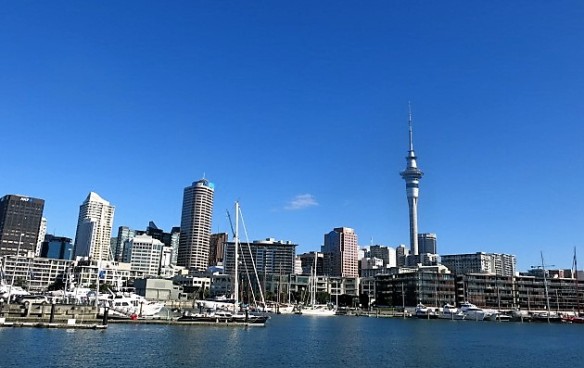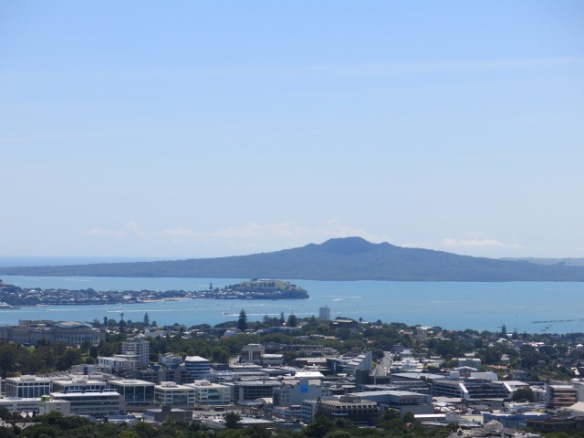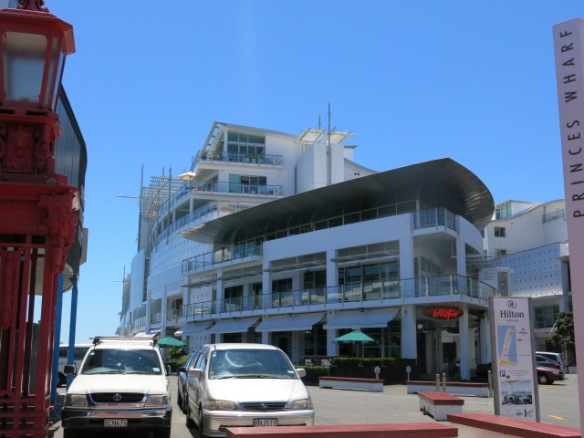
Auckland from the harbor: the Sky Tower soars over all other buildings.
Three important tidbits of information from our driver pierced my jet lag fog as we shuttled into Auckland, New Zealand: (1) Auckland was founded by British so “everyone drove on the left side, so you Yanks watch out;” (2) Auckland was having a heat wave with unusually hot and humid weather (we later scoffed at their definition of humidity – and got royally sunburned in retribution); and, (3) Auckland sat on over 50 volcanoes, many of them active. Five wonderful but searing hot days later we left Auckland sunburned and alive despite constantly forgetting cars came at you from the right, and, with thanks to the still-quiet volcanoes.
The entire country of New Zealand has about 4.5 million people, one third of whom live in Auckland. The city is beautiful, incredibly clean and well organized, with a compact central business district bracketed by miles of waterfront and quaint suburbs perched on volcanic hillsides. The sprawling city straddles the narrowest strip of New Zealand, spreading between Manukau Harbor & the Tasman Sea on the western side, and at the core of the city, the eastern Hauraki Gulf leading to the Pacific.

Rangitoto Island, one of Auckland’s youngest volcanoes. It last erupted 650 years ago. Volcanologists predict if any of Auckland’s 50+ volcanoes will blow soon rather than later, it will be Rangitoto.
Self-appointed the sailing capital of the world, Auckland bristles everywhere with masts of Sali boats and yachts as well as “stinkpots,” a sailor’s term for motorized vessels. If the sea and island vistas don’t convince you, the thousands of sailboats, yachts, ferries, freighters – and more – will make the point: Auckland is entwined with the seas for livelihood, life and pleasure. They even have freighters that haul yachts to Auckland from around the world:

This freighter was carrying over a dozen yachts topside. No way of knowing how many were below decks.
Boats and ships were everywhere. Even if not on the water:

A mixed-purpose structure built in a ship’s form. So very Kiwi!
The central business district (CBD) is very walkable, and you get quite a workout from all the volcanic hills once headed away from the harbor. The sea-to-city theme is always with you, whether in a museum viewing Maori culture displays of wakas (canoes) or pakeha (white Anglo-Europeans) sailing craft, or huffing at the top of Mt. Eden or other high points, marveling at the spectacular city-on-the-water views. And then there’s the Fish Market, where we bought fixings for most of our dinners in Auckland. Smoked broadbill (a large swordfish) is exceptionally tasty.

The Sky Tower glows with an evolving light show at night.
Another must-see landmark is the Sky Tower, which soars above its neighbors in the Auckland sky line. The Tower is where the more intrepid go bungy jumping, while the less courageous go on a tethered sky walk around a wide “lip” of the tower – still way high up there — while the true cowards among us go up the elevator to enjoy the views… Kiwis pride themselves on having a multitude of “adventure sports,” and claim that bungy jumping began in New Zealand.
Side bar: The original tethered jumping began as a rite of passage on Pentecost Island in Polynesian Vanuatu. A few centuries later, an extreme sports group in Oxford, UK, began the modern “sport” of bungy jumping. An enterprising Kiwi called A.J. Hackett saw a video by this group and developed his own harness rig to bungy jump off the Auckland Harbor Bridge. He subsequently bungeed off various high spots around the world, including the Eiffel Tower in Paris. He set up the first commercial bungy jumping business in Queenstown, NZ, which continues to claim (erroneously) to be the birthplace of bungy jumping.

View from the Sky Tower: Far in the distance above the center is the Auckland Harbor Bridge, location of the first “commercial” bungy jump.
Back to sea level: Various signs in Auckland and even the two-story wall of one building detailed the history of New Zealand’s attempts and wins in the vastly popular America’s Cup races. The last 40 years’ history of this yacht race reads like a schoolboy’s tale of bullies in the sandbox, except these guys take each other to court. (National origin of these pugilistic, filthy rich yacht owners doesn’t matter – they all act like spoiled brats when vying for an advantage in the races.) Yet tiny New Zealand has managed to haul in the trophy a number of times. Just as a point of history (I’ll be brief), the trophy is called the “America’s Cup” not because the U.S. has won it more times than any other participating country (which it has), but because the boat that won the initial, British sponsored race in 1851 was called “America.”
The Maritime Museum carries on with the nautical theme, and it’s one of the best such museums I’ve ever experienced. Multiple buildings house various ingenious watercraft from early Polynesians to 19th-20th century vessels used by Anglo-Europeans. Partial replicas of famous racing yachts, among them Peter Blake’s controversial Black Magic, which swept the 1995 America’s Cup, are displayed; the reason for the partial displays, such as half the massive hull of Black Magic, is due to size and space considerations within the museum.
One clever interactive exhibits coached you on how to design your own ocean-racing yacht. Michael tried his hand at racing yacht design. Warning signs kept flashing at him saying, “Your boat is very stable but isn’t going to win a race any time soon.” So he’d extend the sail height and narrow the hull, and kept getting told his boat wasn’t a winner, until….

Whoops. A bit top heavy. Capsized.
In other words, don’t quit your day job.
Auckland has much to offer, and, despite spending five days there, we only scratched the surface. I haven’t given justice to the city, as I’ve focused on a maritime theme, which is my interest and inclination. There is far more to see than I’ve written here. Hats off to Auckland – a fabulous introduction to New Zealand!

Sunset from the Sky Tower.
And on the way to our next stop, I noticed a sign saying, “Dutch Deli” and we just had to stop:

Ahhh…real Dutch cheese. We were in heaven.
It turns out that after WWII, Dutch comprised a huge number of immigrants to New Zealand, so Dutch cheese and other products aren’t as out of place as you’d think. Lucky for us!
![]()

Carol Barbier Rolnick grew up in Japan and Southeast Asia, traveling extensively as a child through Asia, the Mideast and Europe on family vacations. Travel has continued as a priority through raising kids and continuing into retirement, extending adventures through the Americas, southern Africa, Asia, and repeat trips throughout Europe. Carol and her husband, Michael spent four summers based in Utrecht, The Netherlands, which has become like a second home. They are (still) aiming towards Australia-New Zealand and Antarctica to round off their continental travels.








